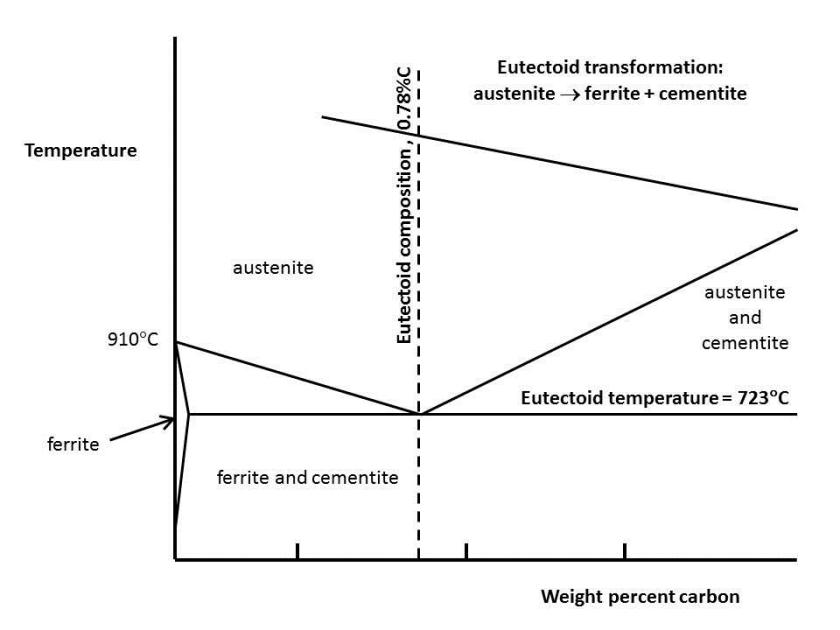We met pearlite a couple of posts ago as a constituent of carbon steel. It is a constituent which is itself made up of two phases. A phase is a region of a material which has a definable structure and specific composition. This is, for the purposes of this blog at least, a good working definition—complex thermodynamics is necessary to fully define what a phase is in a rigorous manner. Pearlite comprises the two phases ferrite and cementite. Ferrite is essentially iron with a body-centered crystal structure, see Figure 2 in ‘C is for Carbon Steel’. In a commercial alloy the ferrite will contain very small amount of carbon and other elements such as Mn, Si and Ni—all in solution, creating what is termed a solid solution. The other phase cementite, or iron carbide, is a compound rather than a metal solution. It therefore has a chemical formula: Fe3C.
So why are we concerned with this constituent named pearlite? The two phases on their own have very different properties. Ferrite, being a metal, is relatively soft and easy to yield and is ductile. Whereas cementite is strong and hard but relatively brittle (it is after all a ceramic). The clever thing about eutectoid steels is that within them it is possible to grow the two phases simultaneously to create pearlite. The pearlite has what is known as a lamellar structure. This can be visualised by imagining a stack of dinner plates. Picture two colours of dinner plates; each one represents a different phase. If you stack them alternately, say red-blue-red-blue-etc. you get something analogous to pearlite. This lamellar structure is defined readily by the spacing between the plates. A coarse pearlite might have a spacing of around one micrometre, but a fine pearlite might have a spacing of only twenty nanometres. This lamellar structure can give rise to a ‘pearly’ appearance under low resolution optical microscopy, hence the name pearlite.
This intimate mixture of two phases at such a small length-scale gives a material which exhibits the best properties of both phases—it is ductile and tough and yet also very strong. This enables it to be drawn readily into wire and better still, this wire gets stronger as the drawing process decreases the spacing of the lamellar even further. For around a hundred years this eutectoid wire has been made and then the wires have been combined in a strand to make very strong and tough cables for lifting heavy equipment and making suspension bridge wires, to name just two applications. The engineering use of a multi-stranded wire is a very resilient solution—should any one strand fail the wire still has a high overall integrity and load-carrying capacity. Has this changed the world? Well moving cargo rapidly and safely, and suspension bridges, are everyday parts of the modern world’s commerce and transport that we completely take for granted. Similar steels have also been used a rail steels for many many decades. In this way eutectoid steels might well be the forgotten enablers of key aspects of the later industrial revolution.
The only remaining issue for this post is the use of the term eutectoid. This is the difficult part and we need to refer to Figure 3 for this. Figure 3 shows something called a phase diagram. For the purpose of this post we can consider this a map of the phases that are thermodynamically stable as a function of composition and temperature. In this schematic part of the diagram for alloys of iron and carbon, there are three phases. In addition to the ferrite and cementite we have discussed we note that another phase, austenite , is stable at high temperature. This is the face-centered cubic form of iron. In Figure 3 we have put a dotted line at around 0.8 weight percent carbon. This is known as the eutectoid composition and is the special composition for which we can readily create 100% pearlite. The horizontal line is known as the eutectoid temperature, this is the upper limit for the formation of pearlite. The reaction, or transformation, of the one phase, austenite to form two phases, ferrite and cementite, in a lamellar form is sometimes termed the eutectoid reaction. All of this does not explain why the word eutectoid is used! This comes from an analogy with other phase diagrams where the high-temperature phase is not a solid but a liquid. Such alloys, like solder, can have low melting points. The Greek word for ‘easily melted’ is euteksis and these alloys are known as eutectic alloys. The ‘oid’ of eutectoid denotes all three phases as being solid and a feature similar to a eutectic on the phase diagram.
Figure 3 A schematic of the Fe-Fe3C phase diagram.